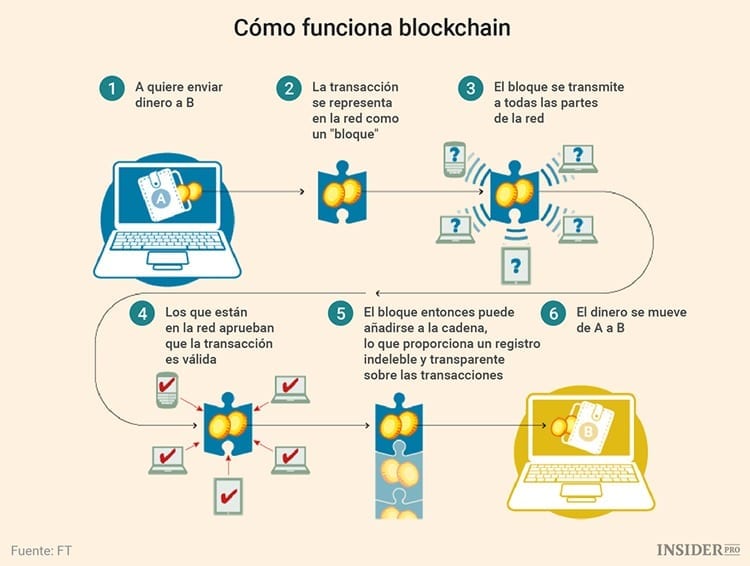Imagine that you are in a park and suddenly you see Spiderman passing over your head. Yes, the real Spiderman, shooting webs from his wrists and jumping between buildings with them. He heads to the park where you and twenty other people are to fight some criminals who are robbing a bank. He finishes them off and leaves the same way he came.

If the police now asked each of the people who witnessed the incident what happened, you would all answer the same thing. It doesn't matter how surreal the event was. There would be no doubt that, if everyone responds with the same details, that this has really happened.
Article Content
What is the blockchain?
This is how it works, roughly speaking, chain of blocks, a technology best known for being fundamental in the use of currencies like Bitcoin, and which has the power to change the way we relate to the digital world.
La technology Blockchain It can mean a revolution in many areas, not just the financial one. It is a method that allows information to be recorded and verified without the need for a physical intermediary, leaving an indelible and totally transparent trail of the transactions carried out using this technology.
No more intermediaries
The previous analogy was perhaps a little surreal, but totally accurate. Let's take an ordinary money transaction as an example. You go to the bank, you give the money to the banker at the counter and tell him that you want to deposit X amount of money into an account. The banker will be in charge of recording the transaction and informing the entity to which the money is issued that adds that amount to his client's account.

In this way, a transaction is recorded in hours (or days depending on the type of transaction) in a traditional bank. But, What if the middleman was eliminated? In this case you have to go through an intermediary to verify the transaction. He receives the money, makes sure it is real and gives the order for that money to be deposited into an account. Blockchain aims to replace these bankers, eliminating the need to comply with the conditions that these banks have and making transaction information completely transparent.
Decentralize Transactions are the basis of the blockchain. It is as simple as preventing one or two banks from being in charge of handling the information. Instead there will be thousands or millions of nodes. those who are in charge of verifying the information, becoming participants in the great account book of this technology in which the information of each block is recorded.
How a Blockchain transaction works
A user wants to make a transaction: transfer a Bitcoin from their account to give it to another user. To carry out this transaction, everyone will be notified that it is about to occur, although taking into account a small detail: Nobody knows the identity of who sends or receives the bitcoin. The only thing they will know is that you want to transfer a Bitcoin from one wallet to another.

In this way a user begins the transaction by notifying users to update their 'account books', that is, the information they have recorded so far. It is confirmed that the transaction is taking place, that the originating account has the necessary funds and a new block is created with the transaction information, which is added to the already existing blocks. But not yet permanently registered.
As time passes, more transactions are completed and added to that block, which has a limited capacity depending on the size of each transaction and the structure of the blockchain. When a block is completed It's time to validate it. This task is carried out by those people who are dedicated to mine Bitcoin.
Mining, an increasingly difficult (and expensive) task
When it was still profitable to mine bitcoins in 2011 and 2012, there was a boom in the number of people who dedicated the power of their graphics cards to the task of mining. Now we meet huge mining farms who seek to make profits from this task. And it is increasingly difficult and expensive to mine this cryptocurrency.
Mining consists of performing a series of complex calculations that, once completed, are permanently recorded on the blockchain, making it impossible to modify without first altering all the blocks that have been previously registered.

The miners fight with each other. They first receive a notice about new transactions taking place on the network, and collect these transactions into a new block. Everyone starts with the verification process but it is only the first to create a valid block and it is verified by the one who receives bitcoins. A service for which the blockchain technology itself 'pays' the miners.
Once a block is added to the existing blockchain it is recorded in the ledger. This is not only distributed among all nodes: it is secure and transparent. Leaving aside the fact that the people participating in the transaction cannot be identified, the timestamp and transaction data are recorded publicly. Additionally, each linked block has an identifier hash which links it to the previous block, thus forming an unbreakable chain.
Thanks to the public information presented by these data blocks, and thanks to the transparency of the network, any transaction can be traced, knowing the path followed by a transaction from the source wallet to the destination one.
The blockchain outside the economy
The essence of the blockchain could be taken to many other sections in addition to the economy, although this is closely related to cryptocurrencies.
The project Ethereum It is a very clear example. This platform has its own blockchain, and also has its own currency (the Ether). The idea of this project is to be able to decentralize almost any service using 'smart contracts', which are the transactions that are carried out through this platform. These contracts are not limited to economic transactions but can define practically any type of transaction.
Decentralization is an issue that is on the order of the day. Bitcoin has been the precursor with its media impact, but just as the Ethereum blockchain emerged, there are many other new alternatives. New projects are constantly created, with different ideas or objectives, but with decentralization as a fundamental pillar of the transactions that will be carried out in the future.

I have been glued to a monitor since a PC fell into my hands in 1997. Now I like to write about everything related to them.
Content writer. Graphic Designer and Search Engine Optimization





